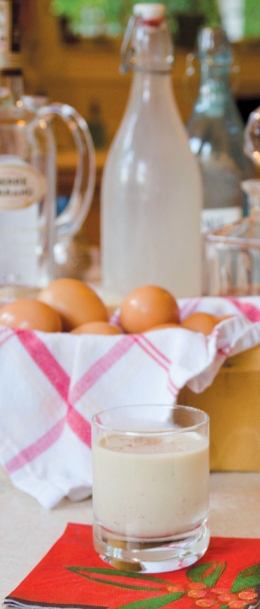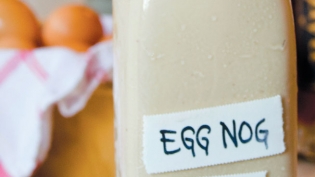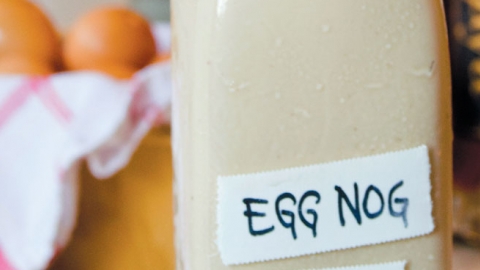Liquid Assets EGGNOG
Eggnog is a weird little beverage. Specific enough to only be available for a brief period time each year, yet not quite fetishized enough to be seasonally injected into every possible edible product the way pumpkin spice has. (I present as evidence: pumpkin spice mole sauce, pumpkin spice Special K cereal, pumpkin spice hummus, pumpkin spice kale chips.) Eggnog slinks onto the grocery shelf the same day candy corn gets marked down 75% and makes an exit quicker than your New Year’s Day J.Roget hangover.
As a kid, I loved it. My brother and I quaffed Coburg eggnog by the quart and he will still barter his last two Reese’s Christmas trees for the last glass. But these days I’m only good for one shot. (Since college, the George family Christmas tradition involves the obligatory family toast from these terrific kitschy snowman shooter glasses that hold an ounce of nog in the bottom and a half ounce of whiskey in the top.) It’s just too much. Too much thickness… too much saccharine sweetness… too much damned nutmeg.
Which brings me to my current situation…
Last September (2015, to be clear), I decided that my contribution to family Christmas was going to be an authentic, honest to goodness, real ingredient eggnog. I did my research, scouring my library of cocktail recipe books and scrutinizing my findings with my two culinary spirit guides, Chef Patrick Wagner of Greenville Tech’s Culinary Institute ot the Carolinas and Alton Brown (one’s on speed dial and the other has a pretty comprehensive website). Since eggnog is traditionally made with raw eggs, I had some decisions to make to ensure that I didn’t give the gift of salmonella.
I could:
a) Heat the eggnog in a saucepan to kill all the nasties that would cause gastric distress. Doing so would mute the flavor, and leave me walking the fine line of taking it off the heat after it had pasteurized (138°), but before I started cooking (144°) the egg;
b) Use a pre-pasteurized egg yolk product… and that’s just cheating;
c) Use the minimum ratio of two ounces of tasty, germ killing booze for every egg included and allow it to sit refrigerated for at least a month to ensure the nasties were eradicated.
I think you know which path I chose.
After a few weeks, I had pared my research down to five recipes from reputable sources with similar enough dairy to ova to booze ratios to create a norm, and then used them to cobble myself a plan of action. Each recipe stated that the nog should marinate a minimum of a month for safety, and pointed out that it would hold fine and continue to mellow the longer it sat.
(pause here for dramatic, soap opera sliding into commercial, “surprise” plot twist brass section cue)
Fully informed, and ever impatient, I built my batch of The World’s Greatest Eggnog Ever in early October, smug with the confidence that it had a solid 2½ months to become majestic before Christmas.
One week later I took a new job that, while being a great opportunity and a solid promotion, kept me from spending Christmas with the family for the very first time. And through November and December, in the fridge, sat The World’s Greatest Eggnog Ever. As 2015 became 2016, it sat. I was hesitant to toss it, not wanting to lose my swing top bottles and my first generation Community Tap growler. And I was hesitant to open and empty the bottles for fear of what olfactory assault might be hiding under the caps. I was still completely dubious of this whole endeavor. So winter became spring, and it sat. And spring became summer, and it sat. Sources claimed, specifically, that the longer it sat, the better it would be. In fact, on Michael Ruhlman’s website, he notes “Place in the refrigerator for at least 3 weeks and up to 3 years (or till it’s as you like it!).” James Beard award notwithstanding, I did not find Ruhlman’s glibness a comfort.
Summer eases into fall and along with it comes a text.
Want to write a piece for the holiday issue of Edible… maybe something on eggnog?
And so here I sit at my kitchen table, staring down a particularly crusty looking bottle of 11-month, 10-day old liquid that I am halfway certain is going to be my demise. A hearty shake of the bottle shows that the liquid seems to be significantly less chunky than the bottle neck belies. Still, I take it outside and far from the house. At the furthest edge of my yard, I hesitantly thumb the wire swing clasp open and am almost disappointed that no odoriferous gas genie of death spews forth. A quick pass under my nose gives no hint of sulfur, just a decided note of booziness and subtle hint of spice.
Back in the kitchen, I strain it into a clean bottle and am surprised that the mesh only catches a couple of the larger grains of crushed nutmeg. It is actually silky smooth with a viscosity no thicker than that of an Irish Crème. But what good is an attractive appearance and pleasant smell if it is toxic to my wellbeing? (here is where I am consciously NOT inserting an ex-girlfriend joke)
Per Cook’s Illustrated, 14% ABV (alcohol by volume) is adequate to kill any potential salmonella. Good thing I have an alcoholometer. (Doesn’t everyone?) If the ABV sits above that, and after that extended length of time, this eggnog should be fairly non-lethal. But there was a problem. The alcoholometer uses a float gauge to measure alcohol content but in this highly viscous liquid, the device floats high and skews the results (shows an ABV of 0%, which one whiff immediately disproves).
It looks like there is no way around it. I am going to taste my eggnog with no real assurance that it is potable. After a scribbled note bequeathing everything I own to my nieces, I pour an ounce into a shot glass, say a prayer to St. Germain (patron saint of overly sweet liqueurs?) and knock it back.
Wow. It is pretty damned good. I mean, solidly delicious.
I am tempted to pour myself another taste, but make myself wait and give any nasties in that small sip the chance to do their damage. An hour later, not being curled in the floor clutching my gut, I pour myself a full glass to celebrate a new Christmas tradition.








